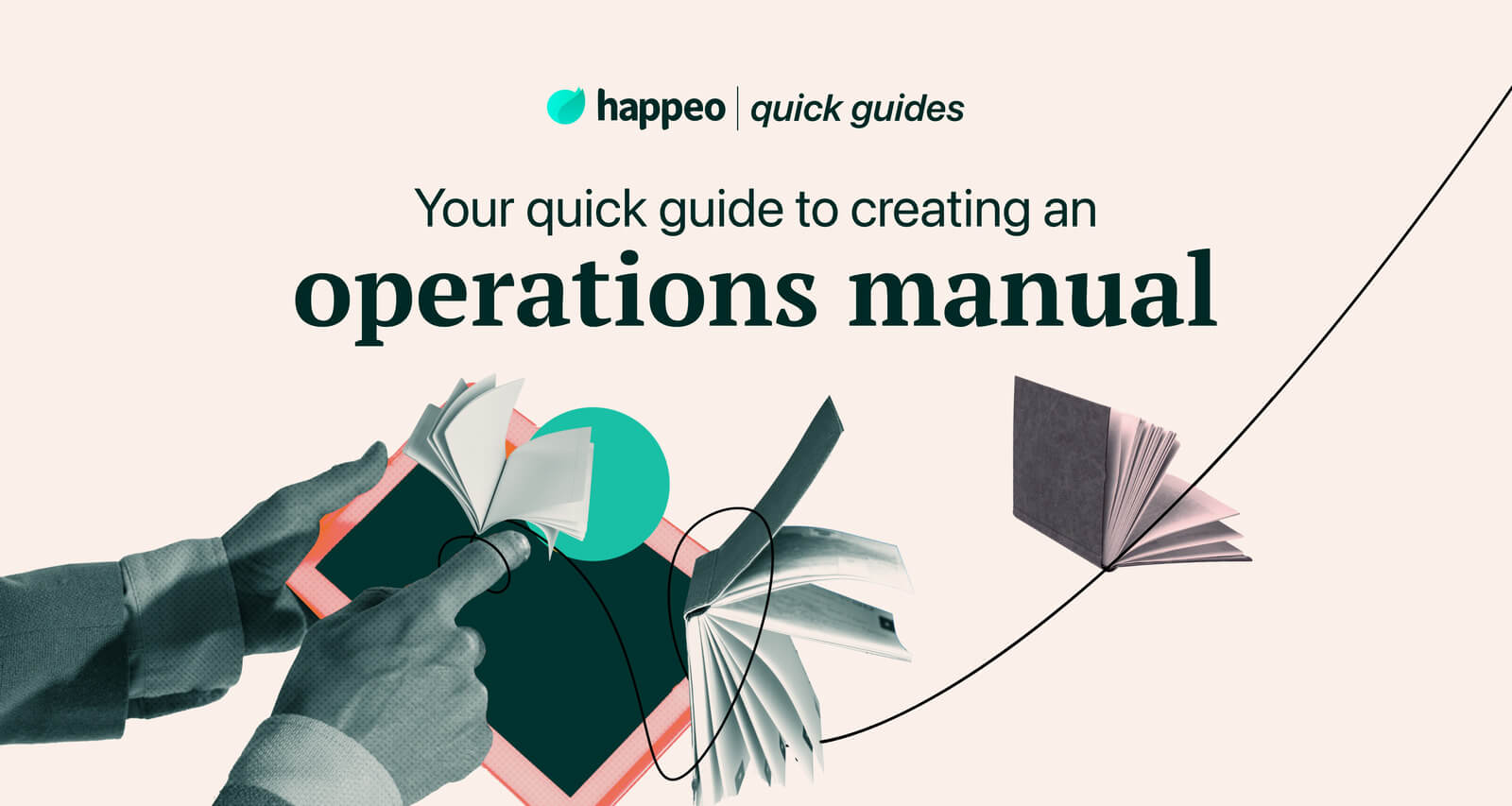
Quick guides
Your quick guide to creating an operations manual (Incl. Template)

7 mins read
Start building your digital home with Happeo
Request a demoQuick guides
Product
Features
Solutions
Happeo for
Use cases
Resources
Explore
Support
Happeo For
Use cases
Comparisons
Explore
Support
Recent

Jonathan Davies
7 mins read
An operations manual is where your teams should go to look up how a particular process works, identify the right person to contact with a question, and even find out what to do in an emergency. It’s essentially an encyclopedia containing all of the information that your employees need to do their jobs.
Are you running a tiny company with just a handful of employees who all intrinsically understand how your business works? If so, you might not need an operations manual — yet. But most businesses grow over time. And there comes a point when it’s no longer possible to answer every question individually.
At this point, an operations manual can help you ensure every employee understands how your company works. Here are some more benefits that an effective operations manual could bring to your organization:
If your operations manual is too detailed and granular, your employees will be overwhelmed with information. On the other hand, if you’re too vague, they might end up more confused than they were to begin with. You need to strike the right balance to make sure you’re giving employees the information they need without overloading them.
When multiple people contribute to a document, you’re bound to get inconsistencies. But your operations manual could confuse your employees if it describes each process in a different way. One solution is to use a template to create your operations manual. This helps you to ensure that your format is consistent and the content is easy to understand.
Your operations manual should provide a clear explanation of how your organization’s operations work, written in simple English that’s easy to understand. If you’re not sure if you’ve hit the right tone, you might want to share your operations manual with a few people from different parts of the business to check if they understand it.
Ready to get started creating your first operations manual? Here are the steps to follow:
The first step is to determine the basic structure you’ll use for your operations manual. That means thinking carefully about the information your teams need (which is different for every organization). Here are some of the sections that are included in most operations manuals:
It’s a good idea to begin your operations manual with some key information about your organization. To begin with, note down the address and other contact details of your corporate HQ and any other locations, and your company’s opening hours.
You could also include a short summary of your company’s history and some key details about the products and services you provide. This ensures that everyone is consistent in how they talk about your company. You might want to end this section with your company vision or mission statement, to remind employees what you’re all working towards.
Next, you need to map out an organizational chart, which helps employees to understand how everyone fits together. The easiest way to do this is with a flowchart. Begin at the top of the page with the CEO, then map out the employees on each seniority level, clearly showing who reports to whom.
Sound complicated? Happeo users can easily create beautiful org charts with just a few clicks by importing data from Azure AD, Okta, or Google Directory. You can use this data to create an organizational chart widget that you can embed into any page — including your operations manual.
You’ll then need to elaborate on your org chart by describing the roles and responsibilities attached to each position. This helps employees to understand exactly what each person is responsible for. It also helps them to understand their own role in the broader context of the organization as a whole.
It’s also a good idea to include contact details for each person. If you create your organizational chart using an online solution like Happeo, this will be automatically imported — and employees will even be able to ping a message through to the person in question through their user card.
The longest section of most operations manuals is the part that sets out your company’s processes and procedures. You’ll need to collaborate with a range of department leads, managers, and other key stakeholders to determine which processes need to be detailed in your operations manual.
Then, you can use business process mapping to clearly lay out each stage of each process in a flowchart that’s easy to understand. You should also separate processes and procedures by department so that people can easily find the ones that are most relevant to them.
Another crucial part of your operations manual is the section that describes your company policies. These might include things like how to communicate with customers, how returns are handled, what counts as suitable workplace attire, and rules for working from home, for example.
Keep in mind that these are not the same as your social policies, which cover things like vacation time, sick leave, benefits, and bonuses. These things would more likely be found in an employee handbook, and don’t belong in your operations manual.
Even if you document every process perfectly, there are always going to be times when things go wrong. That’s why the next stage in creating your operations manual is to clearly outline what employees should do in an emergency. Examples of emergency situations you might want to cover include:
Of course, you won’t be able to cover everything. But by taking the time to brainstorm the most likely scenarios, you can give your employees the information they need to deal with them effectively and minimize damage.
The last step is to create a section that contains all of the important contact details your employees might need. This might include key employees like your office manager, HR manager, or IT support lead. It should also include any external parties that employees might need to contact, such as:
Once you’re happy with your operations manual, it’s time to publish it. You could do this by printing paper copies of your manual and distributing them to employees. However, there are a few problems with this method.
First, employees might lose them, which means they won’t have the information to hand when they need it. You’ll also have to remember to manually print and distribute a copy to every new employee. But most importantly, most companies’ processes, policies, and procedures change over time. And making changes to a physical operations manual is a time-consuming (and often expensive) undertaking.
Instead, you should store your operations manual somewhere where every employee can easily access it, whenever they need to. And in 2023, that means on your company intranet.
An operations manual is a crucial document for any organization. But putting one together from scratch is a long and difficult task.
With Happeo, you can easily create an operations manual using our premade Page Template. The template outlines the most important sections you need to include — all you need to do is populate it with the right information. That means you can create a functional, effective and branded operations manual in far less time.
Plus, an operations manual isn’t a static, one-and-done situation. It’s an evolving, living document that should always reflect the current state of your operations. Creating your operations manual in Happeo means that you’ll be able to edit, update and tweak it whenever you need to — and employees will always be sure they’re working from the latest version.
Want to find out more? Check out our operations manual Page Template to get started.